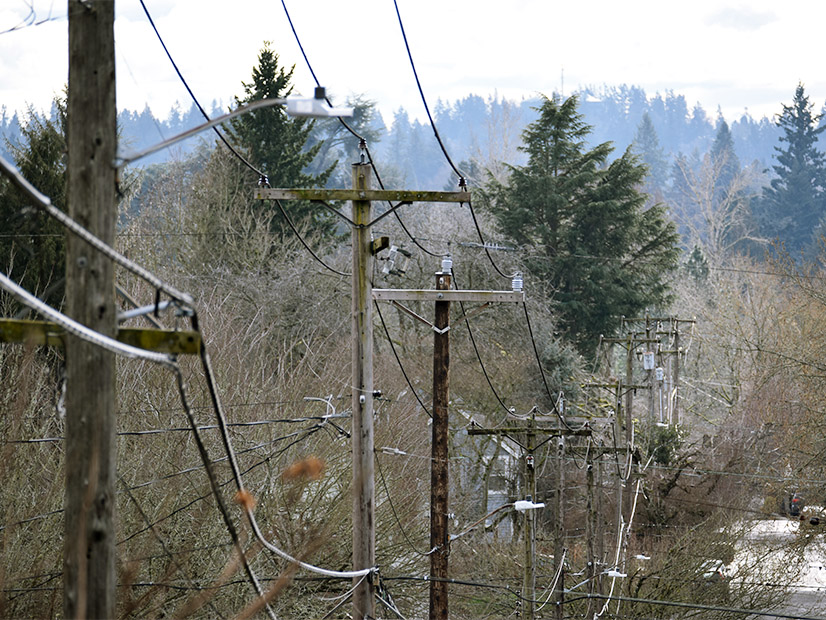Oregon’s investor-owned utilities are asking state regulators to alter key provisions in a newly proposed set of rules designed to bolster utility wildfire mitigation plans.
Portland General Electric (PGE), PacifiCorp and Idaho Power on Wednesday jointly filed a draft of the proposed rules that eliminates a requirement that the IOUs collaborate with other users of shared utility poles, such as telecommunications and cable providers, on 10-year inspections to ensure compliance with wildfire safety standards.
Under current regulations, electric utilities are solely responsible for regular inspection of poles supporting their lines, the costs for which are recovered from ratepayers. In crafting the new rules requiring joint inspections, Oregon Public Utility Commission (OPUC) staff were looking to spread the cost of those inspections to other beneficiaries.
The joint inspection provision emerged as a major sticking point at a Jan. 18 OPUC meeting, when the commission voted to proceed with a formal rulemaking process for the broader ruleset that includes the provision despite utility objections. The commissioners urged commission staff and the IOUs to negotiate a revision for the commission to consider before the rulemaking begins. (See Ore. PUC Advances Wildfire Rulemaking Despite Utility Concerns.)
The IOUs voiced concern about the complexity — and risk — of relying on joint inspections, especially for utility poles in high fire-risk areas that might have multiple users and owners.
“We have significant concerns that the proposed joint inspection mandate will cause delays to find and remediate issues found in high fire-risk zones and inevitably increase wildfire risk,” Larry Bekkedahl, PGE senior vice president of advanced energy delivery, said at the Jan. 18 meeting.
Bekkedahl said PGE preferred to continue the existing policy of solo inspections, a position backed by representatives from PacifiCorp and Idaho Power. Commissioner Mark Thompson sympathized with the IOUs, even suggesting he was disinclined to vote in favor of the rulemaking over doubts that the commission could resolve the joint inspection issue during the formal process.
The IOUs offered a blunt solution to the problem in their redline draft, striking the definition of “joint inspection” and any additional references out of the proposed rules — an approach likely to get pushback from commission staff.
More Redlines
The redline draft also addresses the IOUs’ concerns regarding another section of the proposed rules that could put utilities in conflict with municipal codes when trimming trees away from lines in high fire-risk zones within urban areas. The IOUs’ revisions would clarify that utilities are exempt from local ordinances around tree trimming and removal in such zones, giving primacy to OPUC standards.
Last month, the utilities suggested that the commission modify those provisions to focus utility trimming operations on only the highest risk areas, typically located outside urban areas, thereby avoiding conflicts. They appeared to change tack in response to Commissioner Letha Tawney’s questions about whether municipal codes sufficiently accounted for wildfire risk, raising concerns that ignitions in populated areas could create “real havoc.”
The IOUs suggested additional revisions, giving them more latitude in responding to safety violations discovered on non-utility-owned — or “foreign-owned” — poles, including the right to issues a pole owner a notice that specifies a timeline for repair.
“If the pole owner or equipment owner does not replace the reject pole or repair the equipment within the timeframe set forth in the notice, then the operator of electric facilities may repair the equipment or replace the pole and seek reimbursement of all costs and expenses related to correction or replacement of the reject pole or equipment including, but not limited to, administrative and labor costs related to the inspection, permitting and replacement of the reject pole,” the IOUs wrote.
A utility would also be authorized to charge the pole owner a replacement fee amounting to 25% of the cost of the work.
OPUC will meet again on Feb. 8 to discuss the wildfire mitigation plan rules.


